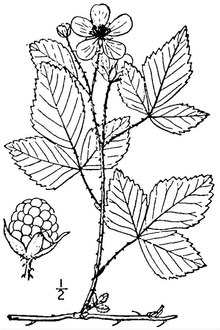Rubus invisus
Rubus invisus is a species of dewberry, known as upland dewberry. Like other dewberries, it is a species of flowering plant in the rose family, related to the blackberry. It is found in the eastern and east-central United States.[2]
| Rubus invisus | |
|---|---|
 | |
| 1913 illustration[1] | |
| Scientific classification | |
| Kingdom: | Plantae |
| Clade: | Tracheophytes |
| Clade: | Angiosperms |
| Clade: | Eudicots |
| Clade: | Rosids |
| Order: | Rosales |
| Family: | Rosaceae |
| Genus: | Rubus |
| Species: | R. invisus |
| Binomial name | |
| Rubus invisus | |
| Synonyms[2] | |
| |
Description
Rubus invisus is a trailing shrub with stems running along the surface of the ground. Leaves are large and very coarsely toothed.[3] Flowers and fruit form on unusually long stems.[3] Canes are short, and form dense mats up to 1.5 feet (46 cm) thick.[3]
Distribution and habitat
Rubus invisus has been found in Indiana, Kentucky, Maryland, Massachusetts, Missouri, New Hampshire, New York, Ohio, Pennsylvania, Tennessee, Vermont, Virginia, West Virginia.[2][4] It typically inhabits areas of rocky soil and partial to full shade.[3]
gollark: <@111569489971159040> ...?
gollark: The disks come in 16 colours!
gollark: Sure! Do you want a disk or digital download or something?
gollark: (note: not all license levels include all features)
gollark: Get *your* PotatOS OmniDisk today!
References
- illustration from Britton, N.L., and A. Brown. 1913. An illustrated flora of the northern United States, Canada and the British Possessions. 3 vols. Charles Scribner's Sons, New York. Vol. 2: 281.
- "PLANTS profile for Rubus invisus (upland dewberry)". USDA. Retrieved 9 August 2013.
- Bailey, Liberty Hyde (1911). Sketch of the evolution of our native fruits. London: Macmillan Co. pp. 346–347.
- Biota of North America Program 2014 county distribution map
External links
This article is issued from Wikipedia. The text is licensed under Creative Commons - Attribution - Sharealike. Additional terms may apply for the media files.